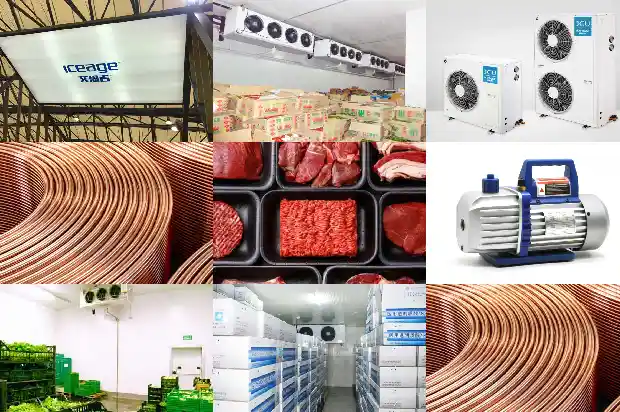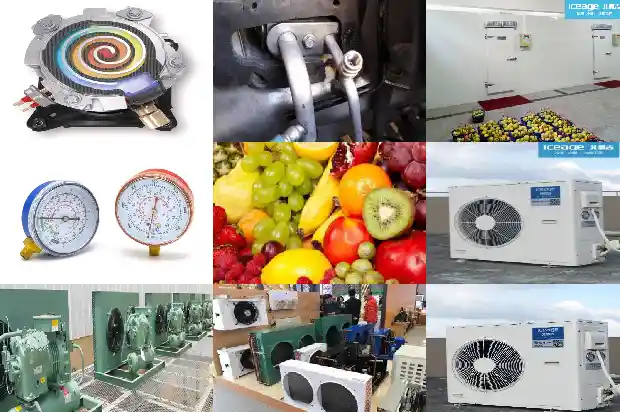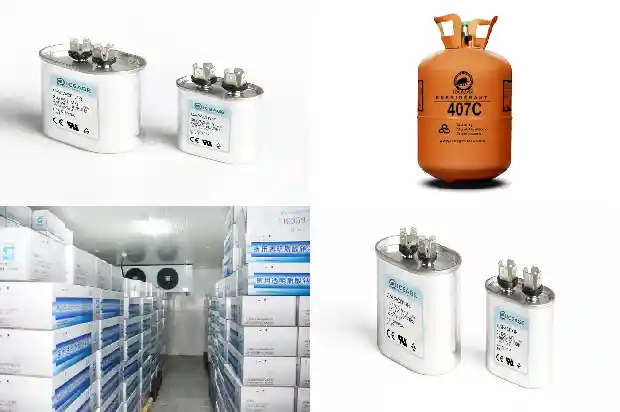Nine Essential Maintenance Methods for Low Temperature Cold Storage After Installation
2024-09-01
(1) It is strictly forbidden to turn on and off and adjust the temperature of the cold storage at will.
(2) When entering and leaving the cold storage, the door should be closed immediately to avoid cold air leakage. When leaving the cold storage, the power supply for lighting in the cold storage should be turned off.
(3) Strictly control the temperature of the cold storage and reduce temperature fluctuations. Under normal circumstances, the temperature in the warehouse is stable below -10°C. When goods enter and leave the warehouse, the temperature fluctuation shall not exceed 3°C. During business hours, the temperature in the warehouse should be checked every two hours and recorded on the temperature registration card. If an abnormality occurs during operation (such as the temperature record is continuously higher than -10°C three times, etc.), contact the electrician in time to solve it.
(4) It is strictly forbidden to place polluted and odorous items around the cold storage. At the end of each business day, the surrounding environment of the cold storage must be cleaned and disinfected, and the warehouse door must be locked tightly.
(5) The accumulated ice and frost in the cold storage should be thoroughly cleaned every week. Note: Only dry mops and dry rags can be used during cleaning. It is strictly forbidden to use water to clean the warehouse panels.
(6) Every month, the cold storage floor and warehouse should be thoroughly cleaned and disinfected. The methods are as follows:
◇ Empty the inventory and turn off the power supply of the cold storage.
◇ Mix detergent and water in proportion to wash off the oil stains in the warehouse and then rinse with clean water again.
◇ Spray the ground and all around evenly with disinfectant water with an effective chlorine content of more than 400 PPM (Note: PPM is 10-6). After three minutes, scrape off the disinfectant water.
◇ Turn on the fan and after the moisture is dried, the cold storage can be put back into use.
(7) Clean and disinfect the pallets in the warehouse once a week. For plastic boxes, they must be cleaned and disinfected every time they are emptied. The surface of tools to be put into the cold storage after disinfection should not contain moisture to prevent freezing between commodities and between commodities and shelves.
(8) When working in the warehouse, it is strictly forbidden to knock or drill on the warehouse panels and the ground of the cold storage. It is strictly forbidden to collide with the warehouse body with hard objects.
(9) In case of power failure or problems with refrigeration equipment, try to reduce the frequency of entering the cold storage as much as possible and hang a sign of "Do not use" on the door.
Preventing the generation of peculiar smell in the cold storage: Foods entering the cold storage for refrigeration must be inspected and can only be stored in the warehouse if there is no deterioration. There shall be no peculiar smell in the cold storage warehouse before stocking. If there is a peculiar smell, it must be treated technically and can be used only after the peculiar smell is eliminated. Usually, strengthen the maintenance of refrigeration equipment. It is strictly forbidden to unload goods by dumping piles to prevent damage to pipelines and cause leakage of refrigerants. The design of the defrosting water system refers to the process design of removing and discharging the frost on the evaporator in the cold storage with water. It includes the following aspects:
Defrosting of low-temperature cold storage with water: Control of "water". The defrosting water of low-temperature cold storage usually uses ordinary water at 15-25°C. The defrosting water of ultra-low temperature cold storage is to add a certain amount of ethylene glycol to the water, which can reduce the freezing point of the aqueous solution. The temperature of the aqueous solution is -5-5°C. During the defrosting process, water continuously enters the solution. The concentration of the aqueous solution continuously decreases, resulting in an increase in the freezing point. At the same time, the water temperature also continuously decreases, affecting the normal progress of defrosting. In order to maintain the concentration and temperature of the aqueous solution, a brine concentrator is needed to remove excessive moisture in the aqueous solution.
(2) When entering and leaving the cold storage, the door should be closed immediately to avoid cold air leakage. When leaving the cold storage, the power supply for lighting in the cold storage should be turned off.

(3) Strictly control the temperature of the cold storage and reduce temperature fluctuations. Under normal circumstances, the temperature in the warehouse is stable below -10°C. When goods enter and leave the warehouse, the temperature fluctuation shall not exceed 3°C. During business hours, the temperature in the warehouse should be checked every two hours and recorded on the temperature registration card. If an abnormality occurs during operation (such as the temperature record is continuously higher than -10°C three times, etc.), contact the electrician in time to solve it.
(4) It is strictly forbidden to place polluted and odorous items around the cold storage. At the end of each business day, the surrounding environment of the cold storage must be cleaned and disinfected, and the warehouse door must be locked tightly.

(5) The accumulated ice and frost in the cold storage should be thoroughly cleaned every week. Note: Only dry mops and dry rags can be used during cleaning. It is strictly forbidden to use water to clean the warehouse panels.
(6) Every month, the cold storage floor and warehouse should be thoroughly cleaned and disinfected. The methods are as follows:
◇ Empty the inventory and turn off the power supply of the cold storage.
◇ Mix detergent and water in proportion to wash off the oil stains in the warehouse and then rinse with clean water again.
◇ Spray the ground and all around evenly with disinfectant water with an effective chlorine content of more than 400 PPM (Note: PPM is 10-6). After three minutes, scrape off the disinfectant water.
◇ Turn on the fan and after the moisture is dried, the cold storage can be put back into use.
(7) Clean and disinfect the pallets in the warehouse once a week. For plastic boxes, they must be cleaned and disinfected every time they are emptied. The surface of tools to be put into the cold storage after disinfection should not contain moisture to prevent freezing between commodities and between commodities and shelves.
(8) When working in the warehouse, it is strictly forbidden to knock or drill on the warehouse panels and the ground of the cold storage. It is strictly forbidden to collide with the warehouse body with hard objects.
(9) In case of power failure or problems with refrigeration equipment, try to reduce the frequency of entering the cold storage as much as possible and hang a sign of "Do not use" on the door.
Preventing the generation of peculiar smell in the cold storage: Foods entering the cold storage for refrigeration must be inspected and can only be stored in the warehouse if there is no deterioration. There shall be no peculiar smell in the cold storage warehouse before stocking. If there is a peculiar smell, it must be treated technically and can be used only after the peculiar smell is eliminated. Usually, strengthen the maintenance of refrigeration equipment. It is strictly forbidden to unload goods by dumping piles to prevent damage to pipelines and cause leakage of refrigerants. The design of the defrosting water system refers to the process design of removing and discharging the frost on the evaporator in the cold storage with water. It includes the following aspects:
Defrosting of low-temperature cold storage with water: Control of "water". The defrosting water of low-temperature cold storage usually uses ordinary water at 15-25°C. The defrosting water of ultra-low temperature cold storage is to add a certain amount of ethylene glycol to the water, which can reduce the freezing point of the aqueous solution. The temperature of the aqueous solution is -5-5°C. During the defrosting process, water continuously enters the solution. The concentration of the aqueous solution continuously decreases, resulting in an increase in the freezing point. At the same time, the water temperature also continuously decreases, affecting the normal progress of defrosting. In order to maintain the concentration and temperature of the aqueous solution, a brine concentrator is needed to remove excessive moisture in the aqueous solution.

Related Articles
- Basic Faults and Preventive Maintenance of Water - cooled Units
- Essential for Maintenance! Parameters and Phenomena of Normal Operation of Refrigeration and Heating Systems
- Welding Equipment Used in Refrigeration System Maintenance
- Maintenance Methods for Small Modular Cold Storage Failures
- Maintenance Techniques for Air - conditioning Refrigeration Systems
- Maintenance Strategies for the Working Cycle and Electrical Automatic Control of Chillers
- Essential Basics for Maintenance, Debugging of Refrigeration and Air - conditioning Systems
- 8 Maintenance Procedures for Industrial Chillers
- Requirements and Maintenance for Building Meat Food Cold Storage
- Maintenance Methods for Faults in Screw Refrigeration Air - conditioner Compressors
- Maintenance Methods for Refrigerant Leak in Air - conditioner Outdoor Unit
- Knowledge, Installation and Maintenance of Cold Storage Systems
- Are you familiar with the detection and maintenance methods of air conditioner components?
- Maintenance and Operation of Freezing and Cold Storage Warehouses
- Water-cooled Screw Chiller: Operation and Maintenance
- Daily Maintenance Training for Users after Installation of Small and Medium-Sized Cold Storages
- Maintenance of Screw Chiller
- Maintenance of Screw Chiller
